

- #Sap ecc ehp7 install#
- #Sap ecc ehp7 full#
- #Sap ecc ehp7 software#
- #Sap ecc ehp7 windows#
On the Parameter Settings, you must select either ‘Typical’ or ‘Custom’.
#Sap ecc ehp7 full#
SAP Full Instatllation: Typical or Custom?.

#Sap ecc ehp7 software#
Most of the options below will just involve selecting the default values.Īs you did before, launch the Software Provisioning Manager using the “sapinst” executable. Here we go! There are a lot of steps in this process however, don’t get intimidated. If everything did NOT go ‘OK’, then you’ll need to do some legwork to find out what the resolution should be. Not sure why this is the case, because we’re just going to hop back in there for the real installation.Īssuming that everything went ‘OK’, then we can now start the full installation of SAP.
Clicking the “OK” button will close out the Software Provisioning Manager. You will also see a message box pop up indicating that the check has been completed and suggesting that you resolve any checks which may have failed. Looks good, you should see an “OK” in the ‘Result Code’ column for each item. You will eventually be presented with a table containing the various elements of the prerequisites check. It won’t take long - maybe 3 or 4 minutes. You will see a 2-phase process start to run. Leaving all the checkboxes empty will only check the critical elements. Hit ‘Next’ twice to accept the defaults for the checking parameters. SAP Business Suite 7i 2013 Support Release 2 –>ĮHP7 for SAP ERP 6.0 ABAP Support Release 2 –> Launch the SWPM using the “sapinst” executable. Following the process I outlined in this series, I never received anything but “OK” messages for each section. This process will perform some hardware and software checks to make sure that the installation can take place successfully. The first thing I did was run the pre-requisites check. There will be two phases to the install: a prerequisites check followed by the real installation. 
While I tried to include as many screenshots as possible, I did omit several steps where I simply chose the default settings proposed by the wizard. When you launch this process, a host of options will be presented each option will include an installation wizard to guide you along the way.
#Sap ecc ehp7 install#
SAP Installation will begin by launching the install process from within the SWPM. …and based on the SAP Note, I changed it to this: compatible ='12.1.0.2' Mine looked like this: compatible ='11.2.0' Mine was located here: D:\app\\product\12.1.0\dbhome_1\dbsĮdit the file using Notepad and find the existing ‘compatible’ parameter.
#Sap ecc ehp7 windows#
In Windows Explorer, navigate to the the ‘dbs’ folder to locate your init.ora file. Reviewing this page, I reviewed the ‘INIT.ORA’ file. However, when I installed client 12.1 I received an error during Database creation indicating that the Oracle ‘Compatible’ parameter was not valid. I had run into an issue later on in the process: The Software Provisioning Manager (SWPM 1.0) prompted me that Oracle client 11.2 was not acceptable it was looking for 12.1. STEP 17: CHANGE ORACLE “COMPATIBLE” PARAMETER
Restart the VM when the installation is complete. On the Summary screen, verify the parameters you selected and click ‘Install’. Just make sure they are pointing to your ‘SAPDATA’ drive, in my case it’s “D:\”. It will recommend using a separate user ID with limited privileges just select “Yes” to continue.įor the installation paths, I left the values defaulted. Select the ‘Use Windows Built-in Account’ option for the “Oracle Home User Selection” screen. Select the ‘Enterprise Edition’ option. Add any additional languages I’m sticking with English. Select the ‘Single Instance database installation’ option. Select the ‘Install database software only’ option (the SAP installer will create the database). It will question your decision just stay strong and remain uniformed. I opted to leave the email address blank and uncheck the “I wish to receive security updates…” checkbox. After extracting the package (package 51047709), you can find the installer inside the ‘database’ sub-folder. So instead I opted to use Oracle 12.1 (database and client), also available from SAP’s site. As noted in Part 1, I had issues when I attempted to use Oracle 11g. I’m not going to cover each single step in detail: I ultimately decide to use ORACLE 12.1 (a.k.a. However, I ran into some compatibility messages when doing the SAP install. If you check out the packages you downloaded from SAP, you’ll notice that it calls for ORACLE 11.2 RDBMS. Now that our VM is configured, it’s time to put some meat on the bones.







 0 kommentar(er)
0 kommentar(er)
